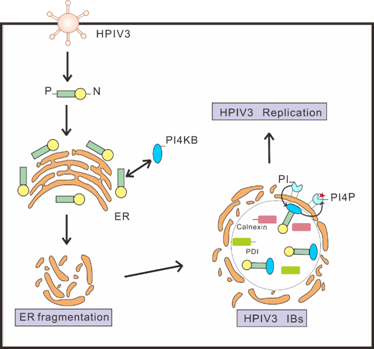On November 19th, Cell Reports, the sub-journal of Cell, published the latest research findings of Professor Chen Mingzhou’s team on replication of the human parainfluenza virus. Prof. Chen works in the State Key Laboratory of Virology in the College of Life Sciences. His work has provided a theoretical basis for the design of a new antiviral drug that directly targets negative-strand RNA virus replication platforms.
The paper is entitled PI4KB on inclusion bodies formed by ER membrane remodeling facilitates replication of human parainfluenza virus type 3. Li Zhifei, a doctoral student from the College of Life Sciences, is the first author. Professor Chen Mingzhou and Associate Professor Qin Yali are co-corresponding authors.
The research is jointly funded by the National Natural Science Foundation of China, the National Key Research and Development Project, the National Science and Technology Major Project and the Science Fund for Creative Groups of Hubei Province.
The Human Parainfluenza Virus (HPIV) is a typical negative-strand RNA virus. It is the major cause of respiratory tract infection among infants, young children and immunocompromised groups. HPIV can cause bronchitis, pneumonia and asthma. However, there is currently no vaccine or antiviral drug that can effectively prevent and treat human parainfluenza virus infection.
Chen’s team have been engaged in the research of the transcription, replication and related molecular biology of unsegmented negative-strand RNA virus for a long time. Previous studies have shown that HPIV3 infection can form inclusion bodies, which are the center of virus replication and RNA synthesis in cells (Zhang et al., 2013; 2017. Journal of Virology). Inclusion bodies also play a role in regulating the antiviral response of host cells. It can conceal the synthesized RNA, thus inhibiting the formation of stress granules (SGs) caused by viral infection and promoting the reproduction of HPIV (Hu et ., 2018. Plos Pathogens).

On the basis of previous work, Chen's team published an article in Cell Reports, revealing that negative-strand RNA viruses use the endomembrane system to form replication sites and gather PI4K kinases to create a membrane lipid environment rich in PI4P, which promotes the replication of HPIV. HPIV fragments the endoplasmic reticulum (ER) and uses the ER components to form inclusion bodies. Fragmented ER prevents inclusion bodies from being hydrolyzed and thus ensures the effective replication of viruses. In addition, the P protein in the virus recruits PI4KB to form a membrane lipid environment rich in PI4P, which effectively promotes viral replication. Finally, Chen’s team analyzed the relationship between PI4K and other negative-strand RNA viruses’ inclusion bodies, and found that HRSV utilizess the nucleoprotein to recruit PI4K to form PI4P in inclusion bodies, which also contain endoplasmic reticulum components.
Link to the paper: https://www.cell.com/cell-reports/fulltext/S2211-1247(19)31366-X
Rewritten by: Liu Tongxv, edited by Cao Siyi, Shen Yuxi, Shi Weiya and Hu Sijia